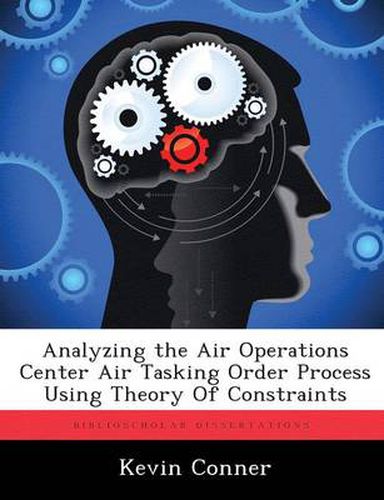Readings Newsletter
Become a Readings Member to make your shopping experience even easier.
Sign in or sign up for free!
You’re not far away from qualifying for FREE standard shipping within Australia
You’ve qualified for FREE standard shipping within Australia
The cart is loading…






This title is printed to order. This book may have been self-published. If so, we cannot guarantee the quality of the content. In the main most books will have gone through the editing process however some may not. We therefore suggest that you be aware of this before ordering this book. If in doubt check either the author or publisher’s details as we are unable to accept any returns unless they are faulty. Please contact us if you have any questions.
This thesis examined the Air Operations Center (AOC) Air Tasking Order (ATO) development process using the Theory of Constraints (TOC). TOC defines a constraint as the variable in production in which a local innovation causes significant global improvement. The overall goal of this research was to identify constraints that exist in this development process, both within a single ATO cycle and across five concurrent overlapped cycles. There has been little documented research on the process of ATO development; much of what is available is either ad hoc, contradictory, or both. Despite this, it is widely agreed that up to five ATOs are concurrently in development at any one time. It is also widely acknowledged that a given ATO from initial conceptualization to execution takes 72 hours, with a daily ATO release occurring every 24 hours. What has not carefully been examined is the lateral interaction between processes within one ATO cycle, nor the vertical interaction between concurrent ATOs under development. Identifying these interactions for possible constraints will focus improvements in this complex command and control process. Using our model we identified specific locations of lateral constraints that often result in information chokepoints, and therefore reduced quality and/or late delivery of the ATO. We also pioneered identification of non-obvious vertical interaction between ATO cycles. Identification of these constraints will allow AOCs to more effectively plan and control ATO development to ensure accurate and on-time delivery of Air Tasking Orders.
$9.00 standard shipping within Australia
FREE standard shipping within Australia for orders over $100.00
Express & International shipping calculated at checkout
Stock availability can be subject to change without notice. We recommend calling the shop or contacting our online team to check availability of low stock items. Please see our Shopping Online page for more details.
This title is printed to order. This book may have been self-published. If so, we cannot guarantee the quality of the content. In the main most books will have gone through the editing process however some may not. We therefore suggest that you be aware of this before ordering this book. If in doubt check either the author or publisher’s details as we are unable to accept any returns unless they are faulty. Please contact us if you have any questions.
This thesis examined the Air Operations Center (AOC) Air Tasking Order (ATO) development process using the Theory of Constraints (TOC). TOC defines a constraint as the variable in production in which a local innovation causes significant global improvement. The overall goal of this research was to identify constraints that exist in this development process, both within a single ATO cycle and across five concurrent overlapped cycles. There has been little documented research on the process of ATO development; much of what is available is either ad hoc, contradictory, or both. Despite this, it is widely agreed that up to five ATOs are concurrently in development at any one time. It is also widely acknowledged that a given ATO from initial conceptualization to execution takes 72 hours, with a daily ATO release occurring every 24 hours. What has not carefully been examined is the lateral interaction between processes within one ATO cycle, nor the vertical interaction between concurrent ATOs under development. Identifying these interactions for possible constraints will focus improvements in this complex command and control process. Using our model we identified specific locations of lateral constraints that often result in information chokepoints, and therefore reduced quality and/or late delivery of the ATO. We also pioneered identification of non-obvious vertical interaction between ATO cycles. Identification of these constraints will allow AOCs to more effectively plan and control ATO development to ensure accurate and on-time delivery of Air Tasking Orders.